B1.1 The world of the Microscope AQA GCSE Biology B1 Cell Strucutre And Transport: Kerboodle Answer Page No. 05
Banner 1
- a) Advantage of light microscope is Cheap to purchase and operate. Disadvantage is that Magnifies objects up to 1500x and Preparation may distort specimen.
Answer b) Advantage of electron microscope is The Scanning Electron Microscope (SEM) can produce three-dimensional images. This means that great detail of many tissue or cellular arrangements can be shown, unlike on a light microscope.
3
| 1. | Living cells & tissues | Can watch living processes take place e.g. microscopic pond life in action, and even cell division. | Not possible to view any living material due to vacuum inside EM |
| 2. | Thickness of specimen | Specimen must be thin but can adjust focus to different positions (heights) within thin specimen on glass slide | Very thin sections only in TEM Images surfaces (only) in SEM |
| 3. | Depth: 2D or 3D ? | Image plane approx “flat” (2D) but, as above, can adjust focus through specimen | 2D only in TEM ; SEM images surfaces – hence shows depth info that seems like 3D |
| 4. | Specimen preparation / artefacts | Simpler preparation (staining still required) | Harsher preparation procedures incl. use of corrosive chemicals that may cause “artefacts” in the resulting micrographs |
| 5. | Magnification | Lower Magnification | Higher Magnification – so several micrographs may be needed per specimen |
| 6. | Resolution | Lower Resolution | Higher Resolution – good for measuring sizes of smaller features |
Banner 2
B1.2 Animal and Plant cells AQA GCSE Biology B1 Cell Strucutre And Transport: Kerboodle Answer Page No. 07
B 1.2 Animal and Plant cells: Kerboodle Answer Page No. 07
- a) The main structures found in the human cell are:
Cytoplasm
Within cells, the cytoplasm is made up of a jelly-like fluid (called the cytosol) and other structures that surround the nucleus.
Cytoskeleton
The cytoskeleton is a network of long fibers that make up the cell’s structural framework. The cytoskeleton has several critical functions, including determining cell shape, participating in cell division, and allowing cells to move. It also provides a track-like system that directs the movement of organelles and other substances within cells.
Endoplasmic reticulum (ER)
This organelle helps process molecules created by the cell. The endoplasmic reticulum also transports these molecules to their specific destinations either inside or outside the cell.
Golgi apparatus
The Golgi apparatus packages molecules processed by the endoplasmic reticulum to be transported out of the cell.
Lysosomes and peroxisomes
These organelles are the recycling center of the cell. They digest foreign bacteria that invade the cell, rid the cell of toxic substances, and recycle worn-out cell components.
Mitochondria
Mitochondria are complex organelles that convert energy from food into a form that the cell can use. They have their own genetic material, separate from the DNA in the nucleus, and can make copies of themselves.
Nucleus
The nucleus serves as the cell’s command center, sending directions to the cell to grow, mature, divide, or die. It also houses DNA (deoxyribonucleic acid), the cell’s hereditary material. The nucleus is surrounded by a membrane called the nuclear envelope, which protects the DNA and separates the nucleus from the rest of the cell.
Plasma membrane
The plasma membrane is the outer lining of the cell. It separates the cell from its environment and allows materials to enter and leave the cell.
Ribosomes
Ribosomes are organelles that process the cell’s genetic instructions to create proteins. These organelles can float freely in the cytoplasm or be connected to the endoplasmic reticulum.
- b) Three extra features that found in plant cell are as follows:
In plant cells is the presence of a rigid cell wall surrounding the cell membrane.
Plant cells chloroplasts is present
Vacuoles are large, liquid-filled organelles found only in plant cells.
- c) Function of three extra structures
Chloroplasts
In animal cells, the mitochondria produce the majority of the cells energy from food. It does not have the same function in plant cells. Plant cells use sunlight as their energy source; the sunlight must be converted into energy inside the cell in a process called photosynthesis. Chloroplasts are the structures that perform this function. They are rather large, double membrane-bound structures (about 5 micrometers across) that contain the substance chlorophyll,
which absorbs sunlight. Additional membranes within the chloroplast contain the structures that actually carry out photosynthesis.
Chloroplasts carry out energy conversion through a complex set of reactions similar to those performed by mitochondria in animals. The double membrane structure of chloroplasts is also reminiscent of mitochondria. The inner membrane encloses an area called the stoma, which is analogous to the matrix in mitochondria and houses DNA, RNA, ribosomes, and different enzymes. Chloroplasts, however, contain a third membrane and are generally larger than mitochondria.
The Cell Wall
Another structural difference between in plant cells is the presence of a rigid cell wall surrounding the cell membrane. This wall can range from 0.1 to 10 micrometers thick and is composed of fats and sugars. The tough wall gives added stability and protection to the plant cell.
Vacuoles
Vacuoles are large, liquid-filled organelles found only in plant cells. Vacuoles can occupy up to 90% of a cell’s volume and have a single membrane. Their main function is as a space-filler in the cell, but they can also fill digestive functions similar to lysosomes (which are also
present in plant cells). Vacuoles contain a number of enzymes that perform diverse functions, and their interiors can be used as storage for nutrients or, as mentioned, provide a place to degrade unwanted substances.
- The nucleus is the most important organelle in the cell. It contains the genetic material, the DNA, which is responsible for controlling and directing all the activities of the cell. All RNAs needed for the cell are synthesized in the nucleus. The nucleolus within the nucleus is the site for RNA synthesis as well as DNA replication.
The chief function of mitochondria is the production of energy during the production of adenosine triphosphate (ATP) via the TCA Cycle (which is also as the Krebs Cycle and the Citric Acid Cycle). That process is an significant metabolic pathway.
Mitochondria are critical to cell endurance in a variety of ways. For instance, they store calcium ions, serving cells maintain the right concentration of these electrically charged particles involved in blood clotting, muscle contraction and other important tasks. Mitochondria create the iron compound that allows red blood cells to ferry oxygen to the body’s tissues.
- Chloroplasts are important cell structures that give vegetation its distinctive green coloring. They are responsible for absorbing energy to feed the plant and power its growth. They are not present in all plant cells. Chloroplasts are only found in the parts of the plant that are capable of photosynthesis. The majority of chloroplasts are found in the leaves of the plant because these structures have the greatest surface area for absorption. The outer part of a plant stem may also contain chloroplasts.
The inner stem cells and underground organs, such as the root system or bulb, contain no chloroplasts. Because no sunlight reaches these areas, chloroplasts would be useless. Fruit and flower cells typically do not contain chloroplasts because their primary jobs are reproduction and dispersal.
B 1.3 Eukaryotic and Prokaryotic AQA GCSE Biology B1 Cell Structure and transport Cells: Kerboodle Answer Page No.9
- a) One of the most drastic differences between the two cell types is how each cell organizes its genetic material. Eukaryotic cells’ DNA is located inside a membrane bound nucleus, from which it does not leave. Their genetic “blueprint” is wrapped around proteins known as histones, which allow the material to condense into chromosomes.
The primary role of the flagellum is locomotion, but it also often has function as a sensory organelle, being sensitive to chemicals and temperatures outside the cell.
(ii) The primary role of the flagellum is locomotion, but it also often has function as a sensory organelle, being sensitive to chemicals and temperatures outside the cell.
- Cell membrane
Both have this lipid bilayer which is an arrangement of phospholipids and proteins that acts as a selective barrier between the internal and external environment of the cell. Due to this, it is necessary for the selective import and export of compounds.
Genetic material Eukaryotic and prokaryotic cells both have deoxyribonucleic acid (DNA) as the basis for their genes. This genetic material needed to regulate cell function and encodes the information which is passed onto progeny.
Ribosomes
Both eukaryotic and prokaryotic cells have ribosomes to produce protein for the cells.
Cytoplasm
In eukaryotic cells (which are nucleated), the cytoplasm is everything between the plasma membrane and the nuclear envelope. In prokaryotes cytoplasm encompasses everything within the plasma membrane.
The cytosol is one major component of the cytoplasm in both prokaryotes and eukaryotes – this solution contains numerous ions, molecules and organelles. Therefore, it is also the site of many metabolic reactions, such as protein synthesis.
Differences between eukaryotic and prokaryotic cells
Cell size
Eukaryotic cells are ordinarily larger (10 – 100um) than prokaryotic cells (1 – 10um).
Cell arrangement
Eukaryotes are often multicellular whereas prokaryotes are unicellular. There are however some exceptions –unicellular eukaryotes include amoebas, paramecium, yeast.
True membrane-bound nucleus
Eukaryotic cells have a true nucleus bound by a double membrane. It contains the DNA-related functions of the large cell in a smaller enclosure to ensure close proximity of materials and increased efficiency for cellular communication and functions.
In contrast, the smaller prokaryotic cells have no nucleus. The materials are already fairly close to each other and there is only a “nucleoid” which is the central open region of the cell where the DNA is located.
DNA structure
Eukaryotic DNA is linear and complexed with packaging proteins called “histones,” before organization into a number of chromosomes
Prokaryotic DNA is circular and is neither associated with histones nor organized into chromosomes. A prokaryotic cell is simpler and requires far fewer genes to function than the eukaryotic cell.
Therefore, it contains only one circular DNA molecule and various smaller DNA circlets (plasmids).
Ribosome size
Both eukaryotic and prokaryotic cells contain many ribosomes; however the ribosomes of the eukaryotic cells are larger than prokaryotic ribosomes i.e. 80S compared to 70S.
Eukaryotic ribosomes also show more complexity than prokaryotic – they are constructed of five kinds of ribosomal RNA and about eighty kinds of proteins. In contrast, prokaryotic ribosomes are composed of only three kinds of rRNA and about fifty kinds of protein.
Cytoskeleton
This is a multicomponent system in eukaryotes composed of microtubules, actin filaments and intermediate filaments. It is required for maintaining cell shape, providing internal organization and mechanical support. It is also paramount in movement and cell division.
B1.4 Specialisation inAnimal cells AQA GCSE Biology B1 Cell Strucutre And Transport: Kerboodle Answer Page No. 11
1.A
The adaptations of a nerve cell are
Nerve cells have very long axons being they can deliver messages for a longer time before passing it on to the next cell, which makes this process significantly faster.
Nerve cell Has many nerves that allow you to sense your surroundings, and allows you to hold and absorb many important nutrients.
- B) Muscle Cell Function, Contains protein, produces movement, maintain structure
Muscle Cell Adaptation
These cells have adapted to their function by being able to increase their size based on the work they do on a regular function
- c) Sperm Cell Function
Penetrates the female egg cell and passes on biological information in order to create a new organism
Sperm Cell Adaptation
Has a head and a tail and overall structure of the cell makes it perfectly designed to carry out its function.
- The nerve endings are adapted to pass the impulses to another cell or between a nerve cell and a muscle in the body using special transmitter chemicals. They contain lots of mitochondria to provide energy needed to make the transmitter chemicals.
- Specialised cells
Cells may be specialised for a particular function. Their structure will allow them to carry this function out.
B1.5 Specialisation in Plant cells AQA GCSE Biology B1 Cell Strucutre And Transport : Kerboodle Answer Page No. 13
- a)
Root Hair Cell Function
Has a large surface area to speed up osmosis, constantly replaced, acts like a sponge and absorbs nutrients
Root Hair Cell Adaptation
For osmosis, the water is absorbed and transported through the roots to the rest of the plant to use for different purposes
- b) Xylem vesselsare involved in the movement of water through a plant – from its roots to itsleaves via the stem. During this process: Water is absorbed from the soil through root hair cells. Water moves by osmosis from root cell to root cell until it reaches the xylem.
- c) phloem transports manufactured food (sucrose and amino acids) from the green parts of the plants to other parts of the plant. the phloem is made up of companion cells and sieve tubes. the cross-walls separating cells are called sieve plates
The adaptations companion cells have many mitochondria, which provide the energy needed for the companion cells to load sugars from the mesophyll cells into the sieve tubes by active transport
holes in the sieve plates allow rapid flow of manufactured food substances through the sieve tubes
- d) Absorbs light energy for photosynthesis.
Adaptation of photosynthetic cell: Packed with chloroplasts. Regular shaped, closely packed cells form a continuous layer for efficient absorption of sunlight.
- Typically the outer layer of bark will prevent sunlight from penetrating to within the trunk. Cells need sunlight to do photosynthesis. Light does not reach the cells in the trunk, and there’s no chlorophyll there.
B1.6 Diffusion AQA GCSE Biology B1 Cell Strucutre And Transport Kerboodle Answer :Page No. 15
- Diffusion. Dissolved substances have to pass through the cell membrane to get into or out of a cell. Diffusion is one of the processes that allows this to happen. Diffusion occurs when particles spread. They move from a region where they are in high concentration to a region where they are in low concentration.
- a) An increase in temperature increases the speed at which molecules move at. An increased speed will yield faster and more even diffusion. A decrease in temperature will cause molecules to slow down. This will slow diffusion and make the spread of molecules less even.
- b) So many cells have folded membranes along at least one surface because as the particles on the outer cell wall are hot and melt the side and diffusion happens slower
Answer d Absorbs light energy for photosynthesis.
Adaptation of photosynthetic cell: Packed with chloroplasts. Regular shaped, closely packed cells form a continuous layer for efficient absorption of sunlight.
- Typically the outer layer of bark will prevent sunlight from penetrating to within the trunk. Cells need sunlight to do photosynthesis. Light does not reach the cells in the trunk, and there’s no chlorophyll there.
B1.7 Osmosis AQA GCSE Biology B1 Cell Strucutre And Transport . Kerboodle Answer:Page No. 17
1.A Diffusion is the movement of particles (atoms, ions or molecules) from a region in which they are in higher concentration to regions of lower concentration. A good example of diffusion is food colouring.
It is the diffusion of a substance through a semipermeable membrane from a more dilute solution to a more concentrated solution. This process is also passive since no external energy is needed. Example: Absorption of water by plant roots.
B Plant cells have a strong rigid cell wall on the outside of the cell membrane. This stops the cell bursting when it absorbs water by osmosis. The increase in pressure makes the cell rigid. This is useful as plants do not have a skeleton. Instead the leaves and shoots can be supported by the pressure of water in their cells. If plant cells lose too much water by osmosis they become less rigid and eventually the cell membrane shrinks away from the cell wall.
The tendency of molecules of a solvent to pass through a semipermeable membrane from a less concentrated solution into a more concentrated one, equalizing the concentrations on each side of the membrane
2.a.i. Isotonic: a solution in which the solute and solvent are equally distributed–a cell normally wants to remain in an isotonic solution, where the concentration of the liquid inside of it equals the concentration of the liquid outside of it
(ii) Hypotonic: a solution which contains more solvent than solute (example: purified water–there’s almost no solute dissolved in the solvent (water) )
(iii) hypertonic: a solution which contains more solute than solvent (example: a lot of salt (solute) dissolved in water (solvent)
- b) Because if the solute is too high, the cell will lose fluid through osmosis. If too low, the cell will gain fluid through the same process. Both can cause the cell to die.
- Answer Osmosis takes place in an amoeba much like any other single-celled aquatic organism, with water diffusing across its cell membrane into the cell because of the higher concentration of solutes in its cytoplasm. Indeed, in many freshwater amoebas, this water movement is constant and at a high rate, enough to damage or even burst the cell if not regularly removed. Fortunately, amoebas have a sophisticated system to remove excess water.
Amoeba has contractile vacuole Because of their constant intake of water via osmosis, water must actively be moved out of the cell with great frequency. Small, membrane-bound bubbles of pure water, collected from the cytoplasm, are brought to the contractile vacuole, which then contracts, pumping its contents back into the environment.
B1.8 Osmosis in plants AQA GCSE Biology B1 Cell Strucutre And Transport . Kerboodle Answer : Page No. 19
- a process by which molecules of a solvent tend to pass through a semi permeable membrane from a less concentrated solution into a more concentrated one
2 When you put the beetroot into a beaker of solution, water will move into or out of the tissue cells by osmosis. If the solution in the beaker is stronger than the solution in the cytoplasm, then the water will move out of the cells. This will make them shrink slightly and so overall the beetroot sample will shrink slightly. There is decrease in the size of beet root.
If the solution in the beaker is weaker than the solution in the beetroot cells then the water will move from the solution and into the cells. This will make them swell slightly and the sample get bigger. There is gain in the size of beetroot.
If the solution in the beaker is isotonic than there is no change in the size of the beet root.
As the concentration of water increased, the mass lost by the beetroot slowly decreased until it was actually gaining mass. This was because it had less water molecule than solution it was in. this was able to happen because the low level of water in the strong solution meant
that the net movement of water molecule was from the beetroot, through partially permeable membrane of the beetroot and into the solution.
The stronger the solution was, the more water had to move from the beetroot to the solution. As the strength of the solution decreased, less water had to move through the membrane from the beetroot. Eventually, the solution was so weak that there was higher water con concentration in the solution than in the beetroot. This meant that the net movement of the water molecules was from the solution to the beetroot. This caused an increase in mass as I predicted.
- Osmosis is important to plants. They gain water by osmosis through their roots. Water moves into plant cells by osmosis, making them turgid or stiff so that they are able to hold the plant upright.
Osmosis ensures that all cells and structures within a plant have correct water pressure and volume.
B1.9 Active Transport AQA GCSE Biology B1 Cell Strucutre And Transport . Kerboodle Answer : Page No. 21
Active transport is the process by which dissolved molecules move across a cell membrane from a lower to a higher concentration. In active transport, particles move against the concentration gradient – and therefore require an input of energy from the cell.
Sometimes dissolved molecules are at a higher concentration inside the cell than outside, but, because the organism needs these molecules, they still have to be absorbed.
There are two types of active transport:
1) Primary Active Transport – Primary active transport, also called direct active transport, directly uses energy to transport molecules across a membrane. Most of the enzymes that perform this type of transport are transmembrane ATPases. A primary ATPase universal to all life is the sodium-potassium pump, which helps to maintain the cell potential. Other sources of energy for Primary active transport are redox energy and photon energy (light).
An example of primary active transport using Redox energy is the mitochondrial electron transport chain that uses the reduction energy of NADH to move protons across the inner mitochondrial membrane against their concentration gradient.
An example of primary active transport using light energy are the proteins involved in photosynthesis that use the energy of photons to create a proton gradient across the thylakoid membrane and also to create reduction power in the form of NADPH.
2) Secondary Active Transport – In secondary active transport or co-transport, energy is used to transport molecules across a membrane; however, in contrast to primary active transport, there is no direct coupling of ATP; instead, the electrochemical potential difference created by pumping ions out of the cell is used. The two main forms of this are antiport and symport.
- a) Active transport requires energy ( ATP molecules ), while osmosis and diffusion require a concentration difference between the cell and its surrounding.
Diffusion is the movement of dissolved solutes or gases from an area of high concentration to an area of low concentration (down a concentration gradient). This is a passive process and so requires no energy in order to take place.
Osmosis is the movement of water down a concentration gradient) across a partially permeable membrane. Once again, this is a passive process and no energy is required.
Active transport is the movement of dissolved solutes across a membrane against a concentration gradient (moving from low to high concentration). This process requires a carrier protein, and energy in the form of ATP is required.
- b) plants must exchange materials with their environment. These exchanges include absorbing water and minerals from the soil and absorbing carbon dioxide from the air for photosynthesis. Therefore plants have specialised exchange surfaces which maximise the efficiency of these exchanges.the roots is to absorb water from the soil by osmosis and dissolve mineral ions from the soil by active transport. the root hair cell contains lots of mitochondria.
- a)
These marine creatures take in too much salt from the sea water that they drink and the kidneys can’t get rid of it.
Special salt glands are found near the eyes and nostrils, and sodium ions are moved here. These ions have to be moved against a very big concentration gradient, meaning active tranport is vital for the birds’ survival.
- b) Active Transport in Plant Cells
Plants require mineral salts such as nitrates for growth. The concentration of nitrates is higher on plant root cell than it is in the soil solution surrounding it. The plant cannot rely on diffusion as the nitrates would diffuse out of root cell into the soil.
B1.10 Exchanging Materials AQA GCSE Biology B1 Cell Strucutre And Transport . Kerboodle Answer : Page No. 23
- Two adaptation of an effective exchange surface are:
Having a large surface area over which exchange can take place
Having a thin membrane or being thin to provide a short diffusion path
- Australian Fitzroy river turtle can breathe underwater. Inside the rear opening are two large sacs lined with finger like folds which provide a large surface area and rich blood supply for gas exchange. The muscular opening pumps water in and out, ventilation the fold and maintaining a steep concentration gradient for gas exchange.
But fish need to exchange oxygen and carbon dioxide between their blood and the water in which they swim. This happens across the gills, which are made up of stack of thin filament, each with a rich blood supply. Fish need a constant flow of water over their gills to maintain the concentration gradient needed for gas exchange. They get this by pumping water over the gills using a flap that covers the gills called operculum.
Summary questions AQA GCSE Biology B1 Cell Strucutre And Transport . Kerboodle Answer : Page No. 25
1.Without microscopes we cannot see most cells.
Light microscopes
show cellular structure of living organisms and some subcellular structures (e.g., nucleus and chloroplasts) allow observation of living cells and staining of cells to show different features
Electron microscopes
enable examination of cells in great detail help determine what goes on within individual body cells can only be used for dead specimens in a vacuum
- a) A: genetic material
B: cytoplasm
C: cell membrane
D: cell wall E: plasmids F: flagella
- b)
size range 10–100 μm
- c) Similarities
cell walls
cell membrane
cytoplasm
Differences
bacteria cells much smaller than plant cells
chloroplasts present in some plant cells
permanent vacuoles present in plant cells
slime capsules present in some bacteria cells
flagella present in some bacteria cells
genetic material contained in chromosomes in a nucleus in plant
cell, single DNA loop found free in the cytoplasm with additional
small loops of DNA known as plasmids in bacterial cell
- d) Bacteria are 1–2 orders of magnitude smaller than eukaryotic cells contain free genetic material can reproduce mitochondria and chloroplasts are similar in size to bacteria contain genetic material so they can reproduce independently of the cell dividing
- a) Similarities
Any one from:
random movement of particles
takes place down concentration gradient
Difference
Only water moves in osmosis
- b) Similarities
Both are mechanisms for moving substances in and out of cells
Differences
Only specific substances are moved by active transport
active transport takes place against concentration gradient
- c) Water will move into both A and B by osmosis as inside of bag is hypertonic to outside.
Water will move into bag B faster than into bag A due to higher temperature.
Increased temperature gives increased rate of random particle movement.
Increasing the rate at which water particles would pass through the partially permeable membrane and speeding up osmosis.
- d) i) useful model though effects of active transport are not demonstrated
(ii) shows what happens inside the cell but does not model effect of cell wall (very important in osmotic events in plant cells)
- a)
Amoeba is single-celled organism with large surface area to volume ratio.
It is able to get sufficient oxygen through diffusion across the cell membrane.
Stickleback is larger, more complex multi-cellular organism with lower surface area to volume ratio.
Diffusion cannot provide sufficient oxygen for each cell, so a more effective exchange system (gills) is required.
- b) Thin filament structure of gills greatly increases surface area available for exchanging gases.
Pushing water across gills increases rate of oxygen absorption by maintaining steep concentration gradient between water and blood.
Circulating blood delivers oxygen to cells.
Removes metabolic waste.
Maintaining steep concentration gradient at exchange surfaces in gills to increase diffusion further.
5.a) large surface area
thin membrane/being thin
efficient blood supply
- b) Large surface area provides greater area over which exchange can take place (e.g., villi in small intestine, alveoli in lungs, plant root hair cells).
Thin membrane/being thin provides short diffusion path/increased efficiency
Efficient blood supply maintains steep concentration gradient Being ventilated
Practice questions
AQA GCSE Biology B1 Cell Strucutre And Kerboodle Answer Page No. 27
1.1. cell membrane
1.2. cytoplasm
1.3. (animal cell does not have)
- cell wall
- chloroplast(s)
- (large) vacuole
2.1. 9 micrometres
2.2. 3.84 (mm)
2.3. (prokaryotic cells) are smaller do not have a nucleus
3.1. Osmosis
water moves from a dilute solution to a more concentrated solution through a partially / semi / selectively permeable membrane
3.2. cut potato cylinders to same mass / size
- use same volume of salt solution
- same temperature
- leave for same length of time
- dry cylinders before weighing
- put cylinders into a range of salt solution concentrations
- measure mass / size at start
- measure mass / size after a day or few days
- repeats
- observe whether the cylinders have increased / decreased or stayed the same mass / size
- correct description of direction of water movement
- conclusion: salt solution concentration in which cylinder did not change in mass / size is same concentration as in cells
Banner 2
Disclaimer
Disclaimer: I have tried by level best to provide the answers and video explanations to the best of my knowledge. All the answers and notes are written by me and if there is any similarity in the content then it is purely coincidental. But this is not an alternative to the textbook. You should cover the specification or the textbook thoroughly. This is the quick revision to help you cover the gist of everything. In case you spot any errors then do let us know and we will rectify it.
References:
BBC Bitesize
AQA GCSE Science Kerboodle textbook
Wikipedia
Wikimedia Commons
Join Our Free Facebook Group : Get A* in GCSE and A LEVEL Science and Maths by Mahima Laroyia: https://www.facebook.com/groups/expertguidance.co.uk/
For Free Tips, advice and Maths and Science Help
This page contains the detailed and easy notes for AQA GCSE Biology Cell Biology for revision and understanding Cell Biology.
Banner 1
AQA GCSE Paper 1: Complete Revision Summary
Cell Biology
4.1 Cell Biology
- Eukaryotic and Prokaryotic Cell
- Animal Cell and Plant Cell
- Specialized Plant Cells
- Specialized Animal Cells
- Microscopy
- Culturing Microorganisms
- Cell Division: Mitosis
- Stem Cells
- Diffusion
- Osmosis
- Active Transport
Eukaryotic Cells – Plants and Animals
Prokaryotic Cells – Bacteria
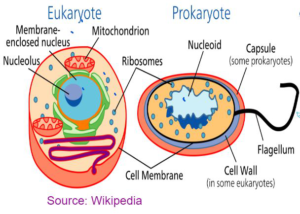
| EUKARYOTIC | PROKARYOTIC |
| Nucleus is present. | Nucleus is absent. |
| All membrane bound organelles are present | Membrane bound organelles are absent. |
| DNA is enclosed in the nucleus | DNA lies naked in the cytoplasm. |
| They are multicellular | They are mostly unicellular |
| DNA is linear | DNA Is circular |
| Ribosomes are big | Ribosomes are small |
| They are big cells | They are small cells. |
| Example: Plants and Animals | Example: Bacterial Cell |
Banner 2
Animal Cells
NUCLEUS
- It is the brain of the cell
- It controls the activities of the cells
- It contains DNA which holds our genetic information.
RIBOSOMES
- It is the site for protein synthesis.
- They are involved in making of proteins and enzymes required by the cell
CYTOPLASM
- Jelly like fluid which fills the cell.
- It is the site where all the chemical reactions of the cells take place as it contains all the major enzymes
CELL MEMBRANE
- It the membrane that surrounds the cells
- It controls what goes in and out of the cell.
MITOCHONDRIA
- It is the powerhouse of the cell
- It produced energy for the cell as it is the site for aerobic respiration
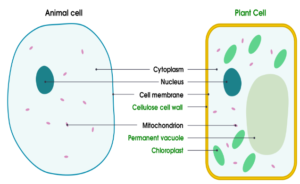
Banner 3
Plant Cell
PERMANENT VACUOLE
- It is filled with cell sap.
- It gives rigidity to the cells and makes the cell turgid
CELL WALL
- Made up of cellulose.
- It is the layer outside of the cell membrane
- It supports the plant and maintain its shape.
CHLOROPLAST
- It is the site for photosynthesis
- It contains a green pigment, chlorophyll which absorbs light and prepared food.
Plant versus Animal Cell
| ORGANELLE | Plant Cell | Animal Cell |
| Nucleus | Present | Present |
| Cell Membrane | Present | Present |
| Mitochondria | Present | Present |
| Ribosomes | Present | Present |
| Cytoplasm | Present | Present |
| Cell Wall | Present | Absent |
| Permanent Vacuole | Present | Absent |
| Chloroplast | Present | Absent |
Banner 4
Bacterial Cell
Cell Wall
- No cellulosic
- made up of peptidoglycan
Circular DNA
- No nucleus
- Single DNA loop found naked in the cytoplasm
Plasmid
- Extra chromosomal materials
- They are in the form of small rings
- They give special properties to bacteria like antibiotic resistance
Pilli
- Hair like structures
- Found on the surface
- That helps bacteria to reproduce
Capsule
- Slime layer
- that protects the bacteria
Flagellum
- Tail like structure
- Helps the bacteria to move.
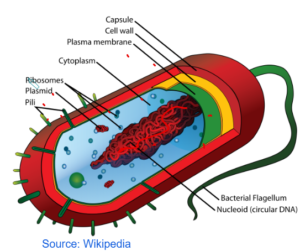
Banner 5
Download the Printable PDF of these notes here :-
[download_after_email id=”5757″]
BACTERIAL VERSUS PLANT VERSUS ANIMAL CELLS
SPECIALISED ANIMAL CELLS
Special cells which have some extra features that allows them to perform specific functions
NERVE CELL
Function is to send electrical impusles round the body
- Dendrites – They are hair like structures that receives the impulses
- Axon – Long stalk the transmits the nerve impulses
- Synapse – They transmit impulses from one neurone to another
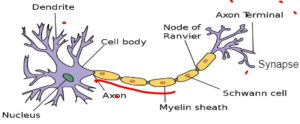
MUSCLE CELL
- Functions is to contract to bring about the movement of different parts of the body
- They are made up of special fibres which helps them to contract and relax
- Contain special proteins that allows them to contract and relax
- They have loads of mitochondria which provides them energy to contract
- They can store special storage carbohydrate called glycogen which acts as fuel for the muscles
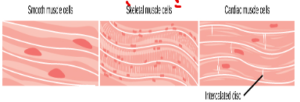
SPERM CELL
Functions is to swim to the egg and fertilize it
- Flagella – Helps it to swim to large distances
- Mitochondria – Provides Energy to swim
- Nucleus – Contains genetic information
- Acrosome – Contains Hydrolytic enzyme to break the egg wall and penetrate inside the egg to fuse with the egg nucleus

Specialized Plant Cells
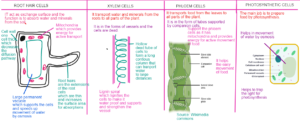
MICROSCOPES
Are the devices that use to see the cells which we cannot see by our naked eye.
MAGNIFICATION
The property of the microscope to enlarge the object.
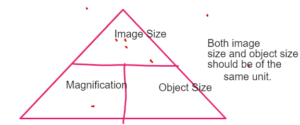
RESOLUTION
The property of the microscope to distinguish between two closed placed objects.
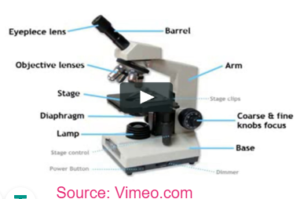
Baneer 6
Light and Electron Microscopes
| LI&HT MICROSCOPES | ELECTRON MICROSCOPES |
| Uses beam of light to focus on the object. | Use beam of electron.to focus on the object. |
| It is easy to handle | It is not easy to handle |
| It is small and compact | It is big and non portable |
| It does not require much expertise to handle | It requires proper training to handle |
| It can view the live samples | Samples have to be dead |
| No special sample preparations are required | Special sample preparations ace required |
| Lower resolving power – 0.2μm | Greater resolving power 0.5nm |
| Small magnifying power – x1000 -1500 | Greater magnifying power – x100000 |
| Can form colour images | Form 2D or 3D black and white images |
Banner 7
MOVEMENT OF SUBSTANCE IN AND OUT OF THE CELLS
ACTIVE TRANSPORT
- Movement of particles from a region of low concentration to a region of high concentration.
- Particles move against the concentration gradient.
- It requires energy.
- Cells involved in active transport should have lots of mitochondria
PASSIVE TRANSPORT
- Movement of particles from the region of high concentration to a low concentration.
- Particles move along the concentration gradient.
- It does not require energy
- Having numerous mitochondria is not a requirement
DIFFUSTON
OSMOSIS
Banner 8
DIFFUSION
- It the net movement of particles from an area of higher concentration to an area of lower concentration.
- It is passive process
- It happens along the concentration gradient
- No use of energy.
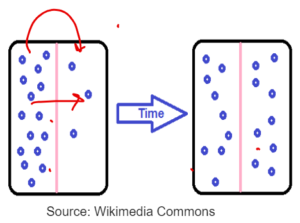
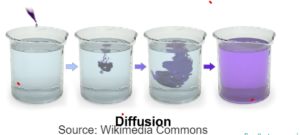
Banner 9
FACTORS AFFECTING DIFFUSION
SURFACE AREA
- Greater the surface area greater is the rate of diffusion as particle will get more room for movement.
- All the exchange surfaces have greater surface area like root cells has root hairs and intestine cells has villi.
CONCENTRATION GRADIENT
- Greater the difference in concentration in the two region greater is the rate of diffusion.
- All the exchange surfaces maintain steepest concentration gradient
- Like root cells are closed to xylem and Villi has rich blood supply.
DIFFUSION DISTANCE
- Smaller the diffusion distance greater is the rate of diffusion as the particles have to travel a smaller distance.
- All the exchange surfaces maintain a smaller diffusion distance by being one cell thick.
TEMPERATURE
- Greater the temperature greater is the rate of diffusion as particles will get more kinetic energy for movement
- Rate of Diffusion = Surface area x Concentration gradient/Diffusion Distance
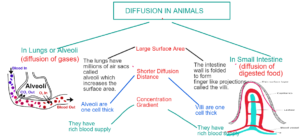
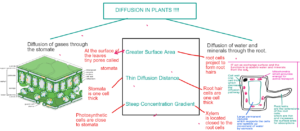
OSMOSIS – Special Case of Diffusion
Osmosis is the net movement of water particles from the region of high concentration of water particles to low concentration of water particles across a semi permeable membrane.
Movement of water from a dilute solution to a concentrated solution through a semi permeable membrane.
Special Case:
- It is the diffusion of only water molecules
- It required a semi permeable or partially membrane
- Membrane that allows only specific molecules to pass through like water.
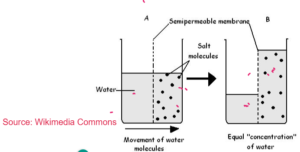
OSMOSIS IN PLANTS
- Hypertonic – The outer solution has a less concentration of water than inside the cell.
- Isotonic – The outer solution has same concentration of water than inside the cell.
- Hypotonic – The outer solution has a greater concentration of water than inside the cell.
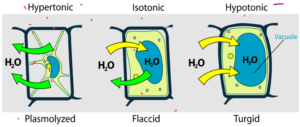
Plasmolyzed – The water moves out of the cells due to osmosis due to higher concentration of water inside the cell than outside. The cell membrane recetes from the cell wall
Flaccid – There will no net water movement so no pressure on the cell. It will be flaccid
Turgid – The water moves into the cell due to osmosis due to higher concentration of water outside the cell. The water will create pressure called turgor pressure on the cell wall making cell rigid and turgid.
Osmosis in Animals
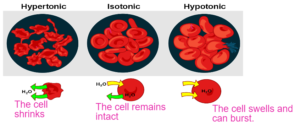
ACTIVE TRANSPORT
- Movement of substances from the region of low concentration to a region of higher concentration with the use of energy.
- Dependent on respiration as it requires energy. So the cells involved in active transport has lots of mitochondria.
- In Plants water and minerals are absorbed by active transport to absorb maximum of water and minerals.
- In animals, the digested food gets absorbed into the blood by active transport to ensure maximum absorption
- Salt glands are present in some marine organisms which removes the salt by active transport.
Banner 10
CELL CYCLE
Interphase –
- It is the longest phase of the cell cycle
- The cell grows in size and prepares all the proteins and enzymes needed for division.
- Replication of DNA where DNA duplicates its content.
Mitosis
- It is the division of the nucleus in which parent cell splits into two daughter nuclei containing same number of chromsomes as the parent cell.
Cytokinesis
- It is the division of the cytoplasm which .takes place after the division of the nucleus.
Mitosis
- It is the type of cell division in which a parent nucleus divides to form two daughter nuclei with exactly the same number of chromomes as that of the parent nucleus.
- The daughter cells produced are genetically identical to the parent and are clones.
- This division is important for growth, regneration and repair.
- Mitosis is also important in asexual reproduction.
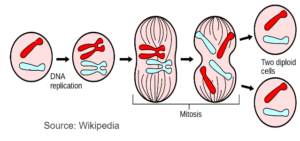
CELL DIFFERENTIATION
- It is the process by which cell becomes specialised to perform a specific function.
- Male Parent (23 pairs of chromosomes) Meiosis
Sperm (male gamete)
- Female Parent (23 pairs of chromosomes) Meiosis
Ovum (Female gamete)
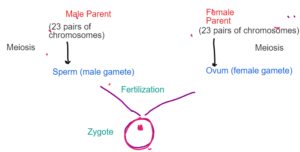
Animal Differentiation
- In animals majority of the cells are differentiated at an early stage and different cells have specific functions like nerve cell, muscle cells.
- Adult stem cells replaced the old and worn out cells in human but adult stem cells have limited specialization power
- Majority of the differentiation is permanent
Plant Differentiation
- Plants are the storehouse of stem cells
- Root meristems and shoot meristems are the parts of actively growing part of the cells which contains stem cells.
- The plants can be cloned easily as it has many undifferentiate cells and differentiation is not permanent.
STEM CELLS
- Undifferentiate mass of cells that can differentiate into any cell type are known as stem cells.
- Sources of Stem Cells : Embryo, left over remains of the embryo and the umbilical chord are the sources of embryonic stem cells.
- Bone marrow is the source of adult stem cells.
- Can solve the rejection problem if the transplanted organ is made from the person’s own stem cells.
- Can be possible cure of neuro-degenerative diseases
- Can be the potential cure of diabetes.
- Therapeutic cloning.
- Organ damage problem
ISSUES AGAINST STEM CELLS
- It can lead to cancer as the stem cells are rapidly dividing.
- The stem cells can be contaminated and can cause unwanted diseases to the patient.
- Research is still slow and expensive
- Research happens on aborted embryos which is considered as a potential source of life and many religions have ethical concerns against it.
- The knowledge of the genes switched on and off using differentiation is still incomplete.
Banner 11
KEY TERMS!!!
- Cells – Basic structural and functional unit of the living organism.
- Mitochondria —The cell organelle which is the site of aerobic respiratiom
- Nucleus — The cell organelle which controls the activities of the cell
- Cytoplasm –The jelly like fluid which fills the cell and contains enzymes for chemical reactions.
- Ribosomes — The cell organelle which is the site for protein synthesis
- Prokaryotic – Cell The primitive cell without nucleus or membrane bound organelles.
- Eukaryotic cell —The advanced cell type with nucleus and membrane bound organelle
- Cell Wall— The outer layer of the plant cell which provide shape and support
- Cell Membrane – The layer that controls what goes in and out of the cell.
- Vacuole – Organelle present in plant cell which has cell sap and make the cell turgid.
- Microscopes – Devices that is used to see the object which are not visible by a naked
- Resolution – Ability to distinguish between closely placed objects.
- Magnification — Ability to enlarge an object
- Xylem – Transport tissue in plants that transports water and minerals.
- Phloem – Transport tissue in plants that transports food
- Diffusion – Movement of substance from a higher concentration to a lower concentration.
- Osmosis — Movement of water from high concentration of water to low concentration of water across semi permeable membrane
- Plasmolysis— Shrinking of plant cell when placed in hypertonic solution.
- Turgid — Fully swollen cell which has gained water by osmosis.
- Flaccid— soft cell due to no net movement of water.
- Mitosis — Cell division that produces identical daughter cells.
- Differentiation – Cell specialization
- Stem Cells – Undifferentiated mass of cells that can specialize to any cell type
- Therapeutic cloning — Using adult stem cells to produce embryonic stem cells and differentiating them to produce a required cell type
Banner 12
Disclaimer:
I have tried my level best to cover the maximum of your specification. But this is not the alternative to the textbook. You should cover the specification or the textbook thoroughly. This is the quick revision to help you cover the gist of everything. In case you spot any errors then do let us know and we will rectify it.
References:
BBC Bitesize
Wikipedia
Wikimedia Commons
Image Source:
Wikipedia
Wikimedia
Commons
Flickr
Pixabay
Make sure you have watched the above videos and are familiar with the key definations before trying these questions. It is also good to time yourself while doing these questions so that you can work on the speed as well.
